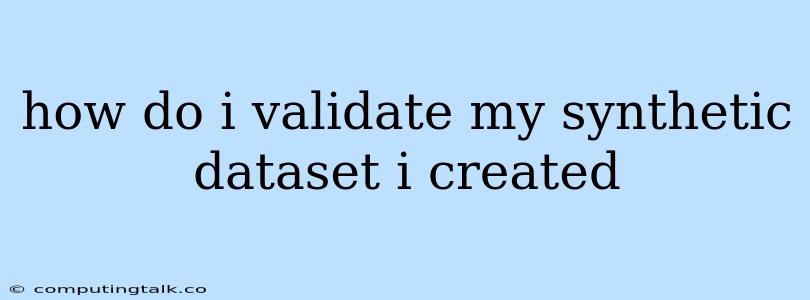How Do I Validate My Synthetic Dataset I Created?
Creating synthetic data can be a powerful tool for various tasks, from training machine learning models to testing software applications. But how do you know if your synthetic data is actually useful and reliable? Validating your synthetic dataset is crucial to ensure it accurately reflects the real-world data it's intended to mimic.
What is Synthetic Data?
Before diving into validation, let's define what synthetic data is. Synthetic data is artificial data that is generated using algorithms to replicate the characteristics of real-world data. It can be used in situations where real data is not available, is too expensive to collect, or contains sensitive information that needs to be protected.
Why Validate Your Synthetic Data?
Validation is essential because synthetic data is only as good as its resemblance to the real data it's designed to represent. Poorly validated synthetic data can lead to:
- Biased models: If your synthetic data doesn't capture the nuances and complexities of real data, it can lead to biased machine learning models that fail to generalize well to real-world scenarios.
- Inaccurate results: Testing with synthetic data that doesn't accurately reflect real data can lead to misleading results and unreliable conclusions.
- Wasted resources: Spending time and resources on building models or testing applications with invalid synthetic data can result in wasted efforts.
Validation Techniques
There are several techniques you can use to validate your synthetic dataset:
1. Statistical Comparisons:
- Descriptive Statistics: Compare basic statistical measures like mean, median, standard deviation, and distribution of key features between your synthetic data and real data.
- Correlation Analysis: Assess the correlation between features in both datasets to ensure that the relationships between variables are preserved in the synthetic data.
- Hypothesis Testing: Use statistical tests (e.g., t-test, chi-square test) to determine if significant differences exist between the synthetic and real data distributions.
2. Task-Specific Validation:
- Model Performance: Train a machine learning model using your synthetic data and evaluate its performance on real data. If the model performs well, it suggests your synthetic data is sufficiently realistic for your specific task.
- Software Testing: Use synthetic data to test your software applications and ensure they handle various input scenarios as expected.
- Data Exploration: Conduct exploratory data analysis on your synthetic data to identify potential issues or biases that might not be captured by statistical comparisons alone.
3. Domain Expert Review:
- Qualitative Assessment: Involve experts in the specific domain you're working with to review your synthetic data for its realism and suitability for your application. They can provide valuable insights that might be missed by statistical or quantitative methods.
4. Visualization:
- Data Visualization: Create visualizations (e.g., histograms, scatterplots, boxplots) to visually compare the distribution of different features in your synthetic data to the real data. This can help you identify areas where the synthetic data might be lacking or misaligned.
5. Using Existing Validation Tools:
- Synthetic Data Generators: Some synthetic data generation tools provide built-in validation features, allowing you to assess the quality of your data before using it.
- Specialized Validation Libraries: Libraries and frameworks like
SynthEvalare designed for evaluating and comparing synthetic datasets to real data, offering a comprehensive set of metrics and tools for validation.
Examples of Validation in Action:
- Fraud Detection: If you're using synthetic data to train a fraud detection model, validate by ensuring that the synthetic data includes realistic patterns of fraudulent activity.
- Healthcare: In healthcare applications, validate synthetic patient data by comparing the distribution of demographics, medical conditions, and treatment patterns to real patient data.
- E-commerce: When generating synthetic customer purchase data, validate that the data reflects realistic purchasing habits, product preferences, and order frequencies.
Tips for Effective Validation:
- Start Early: Incorporate validation into your synthetic data generation process from the beginning.
- Be Specific: Define clear validation goals based on your specific application and the intended use of your synthetic data.
- Iterate and Refine: Continue to validate your synthetic data throughout the development process and adjust the data generation process as needed.
- Document Your Findings: Maintain detailed documentation of your validation process, results, and any adjustments made to your synthetic data.
Conclusion:
Validating your synthetic dataset is an essential step in ensuring its quality and usefulness. By employing various techniques, including statistical comparisons, task-specific validation, domain expert review, and visualization, you can gain confidence in the realism and reliability of your synthetic data. By diligently validating your synthetic data, you can improve the accuracy of your models, enhance your software testing processes, and make better decisions based on data-driven insights.
